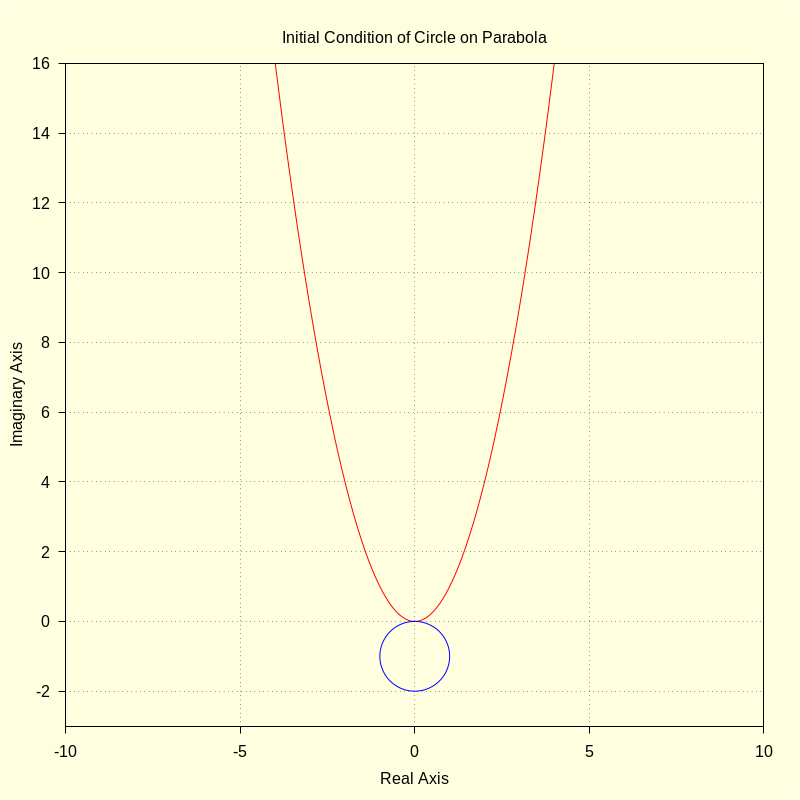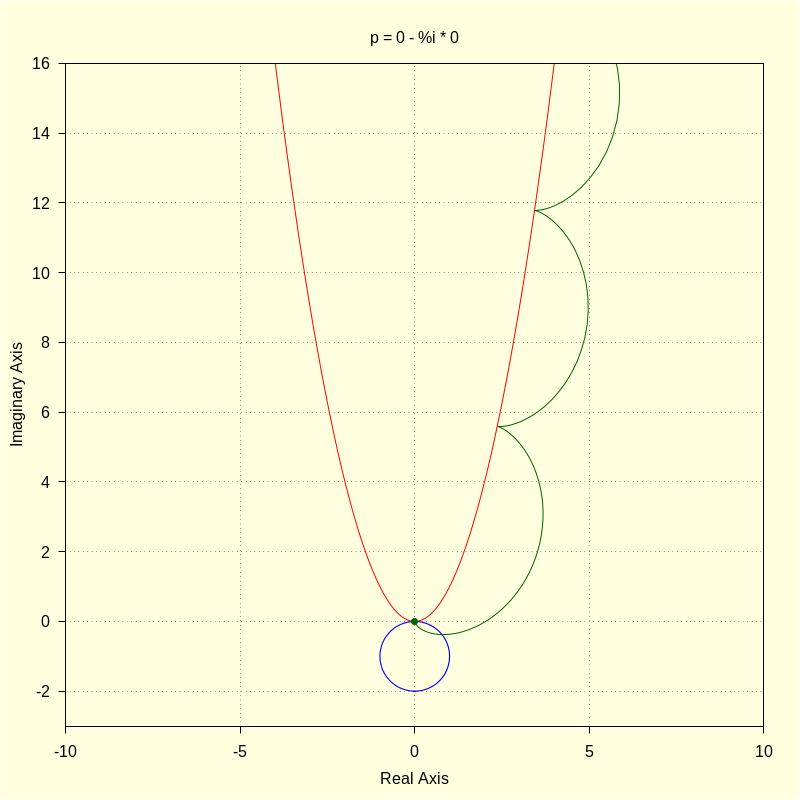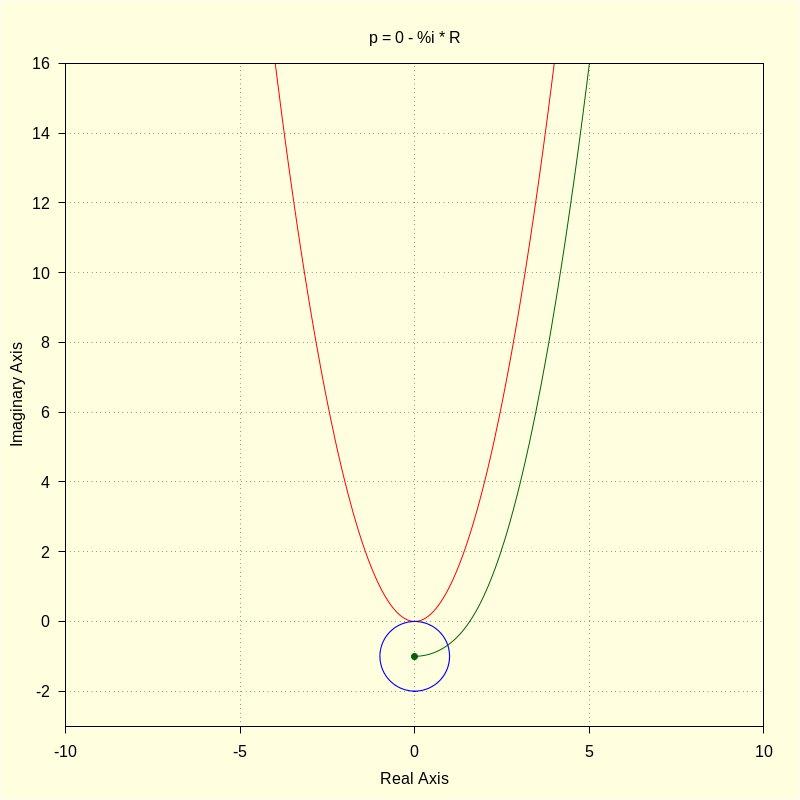\( \DeclareMathOperator{\abs}{abs} \newcommand{\ensuremath}[1]{\mbox{$#1$}} \)
Roulette Curves with GNU/Linux
1) A More Complex Example: Circle Rolling on Parabola
| (%i4) |
kill
(
all
)
$
load
(
draw
)
$
load
(
facexp
)
$
assume ( A > 0 , R > 0 , t > = 0 , u > = 0 ) $ set_draw_defaults ( xrange = [ − 10 , 10 ] , yrange = [ − 3 , 16 ] , proportional_axes = xy , grid = true , nticks = 400 , background_color = light_yellow , xlabel = "Real Axis" , ylabel = "Imaginary Axis" ) $ |
| (%i5) | fx ( t , A ) : = t + %i · A · t ^ 2 ; |
\[\operatorname{ }\operatorname{fx}\left( t\operatorname{,}A\right) \operatorname{:=}t+i A {{t}^{2}}\]
| (%i7) |
define
(
dfx
(
t
,
A
)
,
diff
(
fx
(
t
,
A
)
,
t
)
)
;
define ( sfx ( t , A ) , integrate ( cabs ( dfx ( t , A ) ) , t ) ) ; |
\[\operatorname{ }\operatorname{dfx}\left( t\operatorname{,}A\right) \operatorname{:=}2 i A t+1\]
\[\operatorname{ }\operatorname{sfx}\left( t\operatorname{,}A\right) \operatorname{:=}\frac{\operatorname{asinh}\left( 2 A t\right) }{4 A}+\frac{t \sqrt{4 {{A}^{2}} {{t}^{2}}+1}}{2}\]
The circle is centered at (0, -R)
R * exp(i * u/R) - i * R
Factor out i * R
| (%i9) |
ro
(
u
,
R
)
:
=
%i
·
R
·
(
exp
(
−
%i
·
u
/
R
)
−
1
)
;
define ( dro ( u , R ) , ev ( diff ( ro ( u , R ) , u ) , diff ) ) ; |
\[\operatorname{ }\operatorname{ro}\left( u\operatorname{,}R\right) \operatorname{:=}i R\, \left( \operatorname{exp}\left( \frac{\left( -i\right) u}{R}\right) -1\right) \]
\[\operatorname{ }\operatorname{dro}\left( u\operatorname{,}R\right) \operatorname{:=}{{e}^{-\frac{i u}{R}}}\]
| (%i13) |
A
:
1
$
R
:
1
$
wxdraw2d ( color = red , parametric ( realpart ( fx ( t , A ) ) , imagpart ( fx ( t , A ) ) , t , − 4 , 4 ) , color = blue , parametric ( realpart ( ro ( u , R ) ) , imagpart ( ro ( u , R ) ) , u , 0 , 2 · %pi ) , title = "Initial Condition of Circle on Parabola" ) $ kill ( A , R ) $ |
\[\operatorname{ }\]

| (%i14) | define ( sro ( u , R ) , ev ( integrate ( cabs ( dro ( u , R ) ) , u ) ) ) ; |
\[\operatorname{ }\operatorname{sro}\left( u\operatorname{,}R\right) \operatorname{:=}u\]
| (%i15) | define ( ut ( t , R , A ) , rhs ( solve ( sro ( u , R ) = sfx ( t , A ) , u ) [ 1 ] ) ) ; |
\[\operatorname{ }\operatorname{ut}\left( t\operatorname{,}R\operatorname{,}A\right) \operatorname{:=}\frac{\operatorname{asinh}\left( 2 A t\right) +2 A t \sqrt{4 {{A}^{2}} {{t}^{2}}+1}}{4 A}\]
| (%i18) |
logarc
:
false
$
define ( ro ( t , R , A ) , %i · R · ( exp ( − %i · ut ( t , R , A ) / R ) − 1 ) ) ; define ( dro ( t , R , A ) , ratsimp ( diff ( ro ( t , R , A ) , t ) ) ) ; |
\[\operatorname{ }\operatorname{ro}\left( t\operatorname{,}R\operatorname{,}A\right) \operatorname{:=}i R\, \left( {{e}^{-\frac{i \left( \operatorname{asinh}\left( 2 A t\right) +2 A t \sqrt{4 {{A}^{2}} {{t}^{2}}+1}\right) }{4 A R}}}-1\right) \]
\[\operatorname{ }\operatorname{dro}\left( t\operatorname{,}R\operatorname{,}A\right) \operatorname{:=}\sqrt{4 {{A}^{2}} {{t}^{2}}+1} {{e}^{-\frac{i \operatorname{asinh}\left( 2 A t\right) }{4 A R}-\frac{i t \sqrt{4 {{A}^{2}} {{t}^{2}}+1}}{2 R}}}\]
| (%i21) |
kill
(
A
,
R
)
$
fx ( 0 , A ) ; ro ( 0 , R , A ) ; |
\[\operatorname{ }0\]
\[\operatorname{ }0\]
| (%i23) |
imagpart
(
dfx
(
0
,
A
)
)
/
realpart
(
dfx
(
0
,
A
)
)
;
imagpart ( dro ( 0 , R , A ) ) / realpart ( dro ( 0 , R , A ) ) ; |
\[\operatorname{ }0\]
\[\operatorname{ }0\]
| (%i25) |
cabs
(
dfx
(
t
,
A
)
)
;
trigsimp ( cabs ( dro ( t , R , A ) ) ) ; |
\[\operatorname{ }\sqrt{4 {{A}^{2}} {{t}^{2}}+1}\]
\[\operatorname{ }\sqrt{4 {{A}^{2}} {{t}^{2}}+1}\]
2) Generating the Roulette
| (%i28) |
R
:
1
$
A
:
1
$
p : 0 − %i · 2 · R ; |
\[\operatorname{(p) }-2 i\]
| (%i29) | define ( roul ( t ) , fx ( t , A ) + ( p − ro ( t , R , A ) ) · dfx ( t , A ) / dro ( t , R , A ) ) ; |
\[\operatorname{ }\operatorname{roul}(t)\operatorname{:=}\frac{\left( 2 i t+1\right) \, \left( -i \left( {{e}^{-\frac{i \left( \operatorname{asinh}\left( 2 t\right) +2 t \sqrt{4 {{t}^{2}}+1}\right) }{4}}}-1\right) -2 i\right) {{e}^{\frac{i \operatorname{asinh}\left( 2 t\right) }{4}+\frac{i t \sqrt{4 {{t}^{2}}+1}}{2}}}}{\sqrt{4 {{t}^{2}}+1}}+i {{t}^{2}}+t\]
| (%i30) |
wxdraw2d
(
color = red , parametric ( realpart ( fx ( t , A ) ) , imagpart ( fx ( t , A ) ) , t , − 4 , 4 ) , color = blue , parametric ( realpart ( ro ( u , R , A ) ) , imagpart ( ro ( u , R , A ) ) , u , 0 , 2 · %pi ) , color = darkgreen , parametric ( realpart ( roul ( t ) ) , imagpart ( roul ( t ) ) , t , 0 , 4 · %pi ) , point_type = 7 , points [ [ realpart ( p ) ] , [ imagpart ( p ) ] ] , title = "p = 0 - %i * 2 * R" ) $ |
\[\operatorname{ }\]

| (%i33) |
R
:
1
$
A
:
1
$
p : 0 − %i · 0 ; |
\[\operatorname{(p) }0\]
| (%i34) | define ( roul ( t ) , fx ( t , A ) + ( p − ro ( t , R , A ) ) · dfx ( t , A ) / dro ( t , R , A ) ) ; |
\[\operatorname{ }\operatorname{roul}(t)\operatorname{:=}-\frac{i \left( 2 i t+1\right) \, \left( {{e}^{-\frac{i \left( \operatorname{asinh}\left( 2 t\right) +2 t \sqrt{4 {{t}^{2}}+1}\right) }{4}}}-1\right) {{e}^{\frac{i \operatorname{asinh}\left( 2 t\right) }{4}+\frac{i t \sqrt{4 {{t}^{2}}+1}}{2}}}}{\sqrt{4 {{t}^{2}}+1}}+i {{t}^{2}}+t\]
| (%i35) |
wxdraw2d
(
color = red , parametric ( realpart ( fx ( t , A ) ) , imagpart ( fx ( t , A ) ) , t , − 4 , 4 ) , color = blue , parametric ( realpart ( ro ( u , R , A ) ) , imagpart ( ro ( u , R , A ) ) , u , 0 , 2 · %pi ) , color = darkgreen , parametric ( realpart ( roul ( t ) ) , imagpart ( roul ( t ) ) , t , 0 , 4 · %pi ) , point_type = 7 , points [ [ realpart ( p ) ] , [ imagpart ( p ) ] ] , title = "p = 0 - %i * 0" ) $ |
\[\operatorname{ }\]

| (%i38) |
R
:
1
$
A
:
1
$
p : 0 − %i · R ; |
\[\operatorname{(p) }-i\]
| (%i39) | define ( roul ( t ) , fx ( t , A ) + ( p − ro ( t , R , A ) ) · dfx ( t , A ) / dro ( t , R , A ) ) ; |
\[\operatorname{ }\operatorname{roul}(t)\operatorname{:=}\frac{\left( 2 i t+1\right) \, \left( -i \left( {{e}^{-\frac{i \left( \operatorname{asinh}\left( 2 t\right) +2 t \sqrt{4 {{t}^{2}}+1}\right) }{4}}}-1\right) -i\right) {{e}^{\frac{i \operatorname{asinh}\left( 2 t\right) }{4}+\frac{i t \sqrt{4 {{t}^{2}}+1}}{2}}}}{\sqrt{4 {{t}^{2}}+1}}+i {{t}^{2}}+t\]
| (%i40) |
wxdraw2d
(
color = red , parametric ( realpart ( fx ( t , A ) ) , imagpart ( fx ( t , A ) ) , t , − 4 , 4 ) , color = blue , parametric ( realpart ( ro ( u , R , A ) ) , imagpart ( ro ( u , R , A ) ) , u , 0 , 2 · %pi ) , color = darkgreen , parametric ( realpart ( roul ( t ) ) , imagpart ( roul ( t ) ) , t , 0 , 4 · %pi ) , point_type = 7 , points [ [ realpart ( p ) ] , [ imagpart ( p ) ] ] , title = "p = 0 - %i * R" ) $ |
\[\operatorname{ }\]

3) Final Comments
Also, the power and convenience of using Maxima/wxMaxima to perform the extensive calculations is nicely demonstrated.
Created with
wxMaxima.
Modified and embedded by L.A.P.